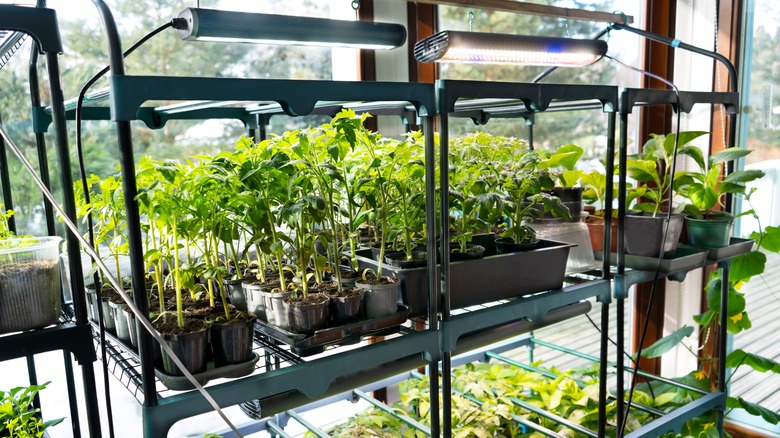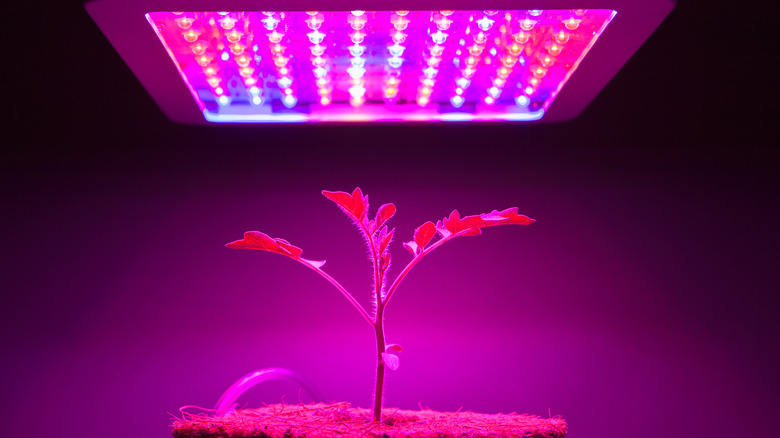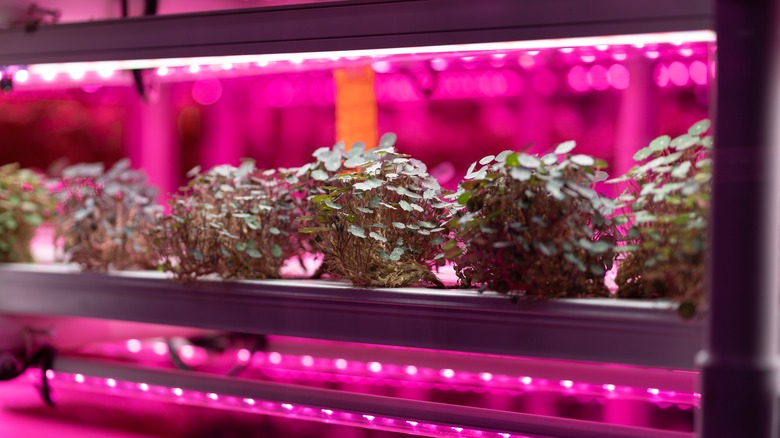Here's The Best Color Light For Plant Growth And Why
With the houseplant craze only growing more prominent, the accessories and tools for plant care and upkeep have become even greater and more widely available both online and at local nurseries or hardware stores. Of these accessories are many LED grow lights. Grow lights have become so popular particularly because they offer extended hours of light to precious indoor plants, extending their growing periods and allowing plant enthusiasts to continue their botanical adventures through the dark winter months or in rooms or spaces with little natural light.
With the emergence of grow lights, there are also now colored LED lights which purport distinct benefits to plants, depending on the color and the desired effect. At one end of the literal spectrum are purple lights. They emit the highest energy through short wavelengths while red lights, at the opposite end, emit longer wavelengths. Each color in the spectrum, with the exception of green light which is reflected away from plants, plays a vital role in plant health and development, and therefore a full-spectrum LED light is the best option for plants' overall health. Though, while there isn't one specific color that is most beneficial to plants, each color offers distinct benefits and can be amplified depending on desired outcome.
Blue and purple light's effects on your plants
Blue and purple light have specific advantages when it comes to plant health, growth, and development. Blue light, with its shorter wavelength, is essential for promoting vegetative growth in plants. It plays a crucial role in regulating plant hormones, particularly auxin, which is responsible for cell elongation and stem growth. Blue light also helps in the development of strong and healthy leaves, as it stimulates the production of chlorophyll, the pigment responsible for photosynthesis. Additionally, blue light can help plants to develop compact and bushy growth, making it an ideal choice for those who want to cultivate dense foliage or bonsai plants.
On the other hand, purple light, which combines blue and red wavelengths, offers a unique advantage to plant owners. It is known to enhance the production of anthocyanins, pigments responsible for the purple, blue, and red colors in plants. Anthocyanins not only provide aesthetic appeal but also have antioxidant properties that protect plants from harmful UV radiation and environmental stressors. Purple light can also stimulate the production of essential oils and resins, which can enhance the flavor and fragrance of certain plants. Therefore, plant owners who want to cultivate plants with vibrant colors, increased antioxidant content, or enhanced aroma may choose purple light to achieve their desired outcomes.
Red and orange light's effects on your plants
Red and orange light also have specific advantages when it comes to plant health, growth, and development. Red light, with its longer wavelength, is essential for promoting flowering in plants. It stimulates the production of a hormone called phytochrome, which is responsible for initiating the flowering process. Red light also helps in the synthesis of carbohydrates, which are essential for energy production and overall plant growth. Additionally, red light can enhance the production of antioxidants and pigments, which contribute to the plant's defense mechanisms and overall health.
On the other hand, orange light plays a role in promoting root growth and development. Having similar wavelengths to red light, orange light can also stimulate the production of a hormone called ethylene, which is responsible for root elongation and branching. Orange light also aids in the absorption of nutrients by the roots, leading to improved nutrient uptake and overall plant health. Thus, when choosing a specific color light for a desired outcome, plant owners should consider their goals and the specific needs of their plants. If your goal is simply to provide additional light to help your green friends grow better, then a full-spectrum LED grow light is your best option.


